Eat Well, Spend Less: Homemade Substitutes for Grocery Staples
Has anyone else noticed the rapidly rising price of food lately?
I have, and I’ve been comparing receipts with several other food bloggers. The results of our research has prompted us to bring you a series to help you spend less while continuing to eat well.
Our series Eat Well, Spend Less will touch on topics such as buying (and storing) food in bulk, frugal meals, menu planning, and much, much more.
Get ready to learn a lot and be equipped for the rising costs of everyday food.
The Big Bucks: Organic Health Foods
The series is about both eating well AND spending less because let’s face it, spending less can be pretty easy: cheap food is abundant in heavily processed form. Sure it is possible to eat on a budget, but eat well? And by well, I don’t mean filet mignon for Sunday dinner, I’m talking about providing our families with wholesome, healthy food. That is the goal of this series.
Robyn O’Brian has a fantastic TED talk where she partly highlights the need for us to reject processed foods and embrace the “real food” movement for the health of our children. It’s powerful stuff. If you haven’t watched the clip, I definitely recommend making it a priority. (My latest multi-tasking duo is folding laundry and listening to TED talks on YouTube.)
I think it’s fair to say that the more processed our food becomes, the lower the price drops. The items that generally increase my grocery bill are the ones that are best for me: organic products, made with real ingredients, that have been treated with respect. Because I care about what I serve my children and I put into my own body, I pay a higher price for organic or natural products – unless I can make them myself for less, which is often the case.
Why pay $4 for a container of organic chicken broth when I’ve got the carcasses from last night’s dinner that I can simmer down to make fresh stock? Why get gouged $6 for a small bag of granola when I can get the raw oats for $1 and make my own with the kids after school?
Not only is it cheaper to make your own real food staples, you know exactly what is going into your food. You can customize each item- be it a condiment, salad dressing or spread – to suit your family’s needs, avoid allergens and cater to taste preferences.
Homemade Substitutes for Grocery Staples: Important Factors to Remember
- Food should be purchased and preserved in season. This is the best way to save money. Example: stock the pantry with canned tomatoes in September when they are practically giving them away.
- Ingredients should be purchased in bulk when possible. The advantage is a reduced unit price. Go in on big purchases with a friend, if needed.
- Set aside a realistic amount of time to make your homemade grocery staples. Accept that it is going to require some time, and remember that you will get faster as you gain experience. Team up with a friend on major canning projects and organize preserve swaps to gain a varied selection.
- Start small. Don’t attempt everything on the list below or you may become overwhelmed and give up. Instead, start with two staples such as one salad dressing and one pancake syrup. Once you are making these regularly, add two more items, and so on.
Pantry Staples from Scratch
Katie and I are collaborating to bring you homemade versions of pantry (and fridge and freezer) staples. She is covering ‘dry’ items and I will elaborate today on ‘wet’ products. So that means head over to Good Life Eats for baking mixes, granola bars, and more dried goods.
If you think about it, many basic ingredients and foods that we consume daily or weekly can be made from scratch for much less than it costs to buy prepared. As described above, smart shopping by buying in bulk and in season can also dramatically increase savings.
I can honestly say that, with the exception of ketchup and dill pickles (which I intend to attempt this summer) I make all of the following kitchen staples from scratch. And you know what? It doesn’t seem like such a big deal. Maybe because it’s become a way of life for me; a conscious choice.
I know why I can my own food, I understand the importance of healthy food culture, and I’m not afraid to roll up my sleeves and put in some long hours in the kitchen to benefit my family – and save some coin in the process.
I hope you are encouraged to do the same.
Stocks
- Chicken Stock
- Brown Stock
- Turkey Stock :: Food for My Family
- Fish Stock :: Artistta
- Vegetable Stock
Salad Dressing
- Balsamic Vinaigrette
- Buttermilk Ranch Dressing
- Clementine-Coriander Vinaigrette
- Garlic-Herb Vinaigrette
- Maple Dijon Vinaigrette
- Maple-Poppyseed Dressing
- Maple Shallot Vinagrette
- Maple Vinaigrette with Cocoa Nibs
- Spicy Maple Vinaigrette
Sauces
- Classic Bolognese :: Verses from My Kitchen
- Summertime Pesto
- Pear Sauce :: Good Life Eats
- Tangy Barbeque Sauce
- Classic Applesauce
- Four-Ingredient Tomato Sauce
- Quick Peanut Sauce
- Roasted Tomato & Garlic Pizza Sauce
Syrups
- Apple Cider Syrup :: Good Life Eats
- Cranberry Orange Maple Syrup :: Good Life Eats
- Honey-Orange Syrup
- Molasses-Cinnamon Syrup
- Sweet Summertime Blueberry Syrup
- Vanilla-Rice Syrup
Spreads
- Homemade Nut Butter
- Marisa’s Apple Butter
- Nectarine Raspberry Freezer Jam
- Pink Grapefruit & Pomegranate Marmalade
- Rhubarb-Pear Butter
- Strawberry-Rhubarb Micro-Mini Jam
- Vanilla-Spiced Pear Butter :: Good Life Eats
- Pear Cranberry Compote
- Honey-Sweetened Apricot Lavender Butter
Condiments
- Cultured Salsa
- Green Tomato Chutney :: Food in Jars
- Quick Pickled Onions
- Restaurant-Style Salsa :: Good Life Eats
- Tomato Ketchup
- Extra-Garlic Dill Pickles (Traditional)
- Homemade Harissa
- Garlic-Dill Cucumber Pickles (Lacto-Fermented)
- Chimichurri
Dairy
- Buttermilk :: Good Life Eats
- Crème Fraîche :: Chocolate Chip Trips
- Homemade Yogurt
- Creamy Homemade Ricotta
Other
Do you feel like it costs too much to feed your family RIGHT?


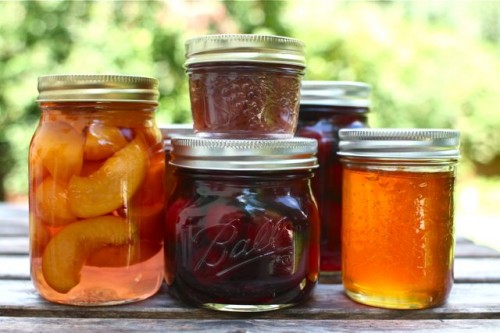
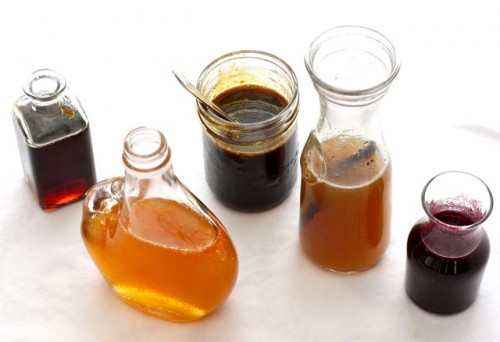
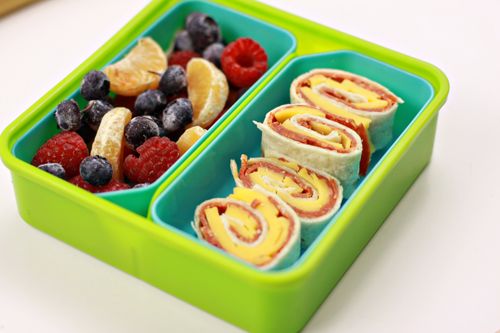
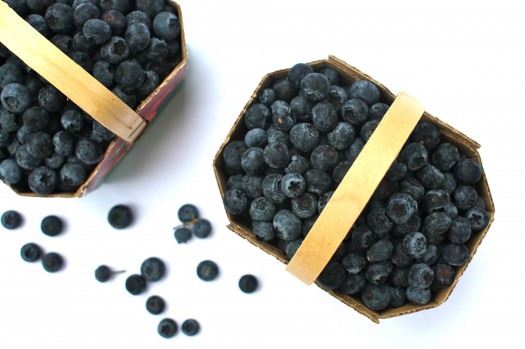
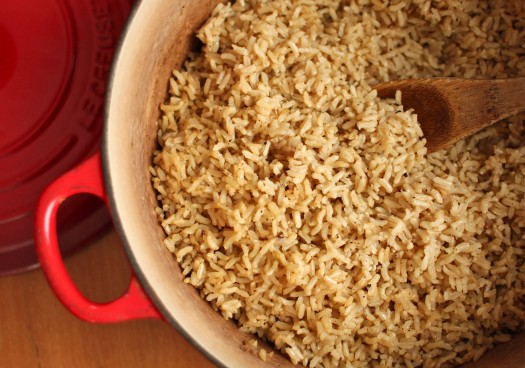
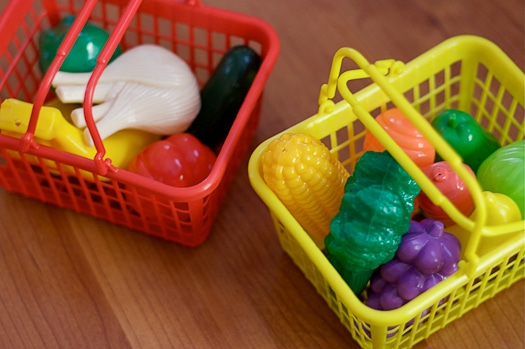
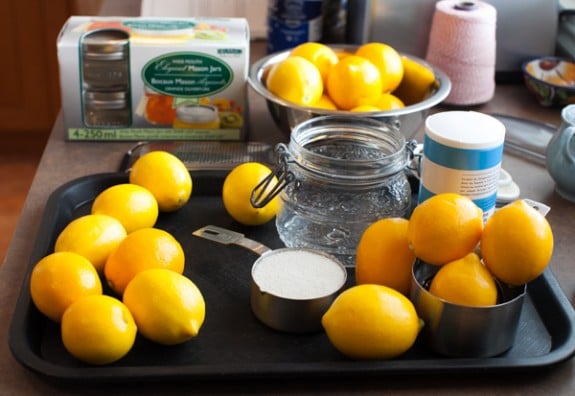
Wow! That’s an impressive list of things you make from scratch – well done! There are some real gems in there that I can’t wait to try.
Hi Kelly, Of course I don’t *always* have everything on the list on hand, but for the most part, yes, I make them from scratch. My mother always did, so I grew up with homemade yogourt, jam and salad dressing.
I have a silly question. Can you recommend what you put it all in and any money saving tips? I find the thing stopping me from going all the way eeeis the investment in containers. See silly .;)
This isn’t a silly question at all, Cristie. With the high price of good Tupperware and cute vinaigrette bottles, it is a valid query.
For the most part, I use glass jars of all shapes and sizes. I check out garage sales and thrift stores for canning jars large and small. I also recycle jars that come in to the house. Nearly everything listed above is shaken together, stored or frozen in a glass jar.
wow, thanks ! I can’t wait to try the ricotta recipe !! and the molasses syrup. And the vanilla and pear spread. And… well… everything !!! Thanks to you !
Great, Cat! Remember not to take on *too* much at the beginning. 🙂
so excited about this.
What an extensive list! Wow!!!
I’m not sure what to try first.
Thanks!
Great post! I’m looking forward to the series. Thanks for sharing!
~Liz
Thanks for stopping by, Liz. Stay tuned!
I’m looking forward to this series, I’m always looking for way to save money but I’m not willing to sacrifice quality. I try to make as much as possible from scratch when I can as well.
Sounds like we make similar choices when shopping, Sylvie. You’re definitely an inspiration when it comes to scratch cooking.
This is wonderful! I am really looking forward to this series and going through the recipes. I have been making my own salad dressings lately. They are so easy and refreshing. My kids even like them which is a big bonus! My two favorites are Buttermilk Dressing and Dijon Vinaigrette. Yum!
Thanks, Aimee for all the great links!
Homemade vinaigrette is a fantastic start, Megan – your favorites sound similar to mine. 🙂
I’m really annoyed lately by the rising cost of good bread.
I used to make all of our bread, but I’ve been working outside the home lately and I find that that is the thing that has most fallen by the way side. Store bought bread is so convenient! And to buy the good stuff is about $4-5, but if we go through a loaf in a day it really adds up. I’ve cut back on my hours lately so perhaps I can get back to making most of our bread again.
On the other hand, I am really enjoying the 120kg of roma tomatoes that I got for $60 and canned last summer. My family of 5, my parents and my brother and his Italian wife are all still enjoying the canned pureed tomatoes. It worked out to about $0.60 per litre. Compare that to $1.29 $1.89 for 750ml of store bought tomatoes.
For the poster above who asked about affording containers, the principle is the same as adding homemade things to your routine. Each year, you just buy what you can afford to put up a few things. About 4 years ago I bought enough small jars to make several batches of jam. It was about $50 for all the jars and equipment and ingredients. But I got enough jam for my family as well as teacher and Christmas presents for everyone. The next year I bought a few more jars and made jam and fruit butters. The next year I bought big jars and a tomatoe press thing and canned tomotoes and jam and beans and pizza sauce and fruit butter. I’ve never spent more than $100 in a summer on canning ingredients and equipment. This year I plan on getting a big pressure canner and that way I can more quickly can low acid things.
That is a fantastic savings on canned tomatoes, Faustina. I want to can a lot more Roma’s this year. If I wait until late September, they get quite cheap at the market.
Have you checked to see if you have a bread outlet nearby? I go to an Aunt Millies one, and they have organic, whole grain loaves for $1.39! And non-organic whole grain, hfcs free, loaves for .89.
I’ve never heard of a bread outlet. Would that be like a factory outlet for clothes? I’m pretty sure that there aren’t any large commercial bakeries in my city. There are several smaller commercial ones, but they serve the high-end food market.
here’s the one i shop at, but several other brands have them too, like butter nut etc. it’s usually a small store where they sell overstock, and store returns (bread that’s getting close to date so they pull it). But nothing is expired 🙂
you should look into “Artisan Bread in 5 minutes a Day”, it’s just me and my husband right now, but I love the convenience of pulling out a handful of dough and sticking it in the oven when I a little bit of time on my hands
That is what I use. I take their basic recipe and make two larger longer loaves out of it instead of three small ones. That lasts us about a day and half, maybe two days depending on what we’re having for dinner.
I don’t really like taking it out of the fridge because it has to rest at room temp for about 45 minutes before baking. I find that it is really hard to remember to take it out of the fridge in time, so that I’m not waiting for it to bake at 11pm. And I don’t want to get up early enough for it to rest, bake, rest in the morning.
Yesterday and this morning is a good example. I was at work all weekend, so Monday was spent cleaning, doing laundry, taking kids to school and swimming lessons. I made dinner, brownies with the 8 year old and muffins after kids were in bed. This morning I used the last of the bread for lunches and I wanted to start on some dough before going to work around noon, but I had to vacuum and mop and do more laundry after the kids went to school. Now I have to get myself washed and dressed and take the toddler to preschool before going to work. Tomorrow I’ll probably take the frozen loaf of store-bought bread out of the freezer for lunches because I just won’t have had time to coordinate even the simplified ‘ABi5MaD’ bread.
But that’s the point that Aimee is always making. You do what you can, when you can. And anything you do is going to be better for you and your family than the store-bought version and will benefit you and your budget.
Do you have issues with the jars breaking in the freezer? Any tips to avoid this? It is heartbreaking when you simmer broth for 2 days, jar it, refrigerate to cool completely, freeze, and then find the jar cracked when you take it out to use it!
Mary, I’ve had just one jar break, and I think that was just because it got bashed around in the deep freeze. Oops! I take care to leave a LOT of head space for expansion, and that is the only tip I have really.
Perhaps readers have more tips?
Once the jar is filled, I place the lid on the jar, but I DON’T screw it on. I then place the jar (carefully) in the freezer overnight. After that, I go back and screw the lid on, since the expansion due to freezing has already taken place.
I know plastic bags aren’t everyone’s favorite, but another idea is to cool the stock/broth completely in the refrigerator, and then fill gallon size freezer bags with the stock. Freeze the bags overnight on a cookie sheet (to prevent leaks from spreading). Once the stock is frozen you can store it the freezer, either standing up or laying down.
You need to use straight edged jars for best results, the more of a shoulder there is the more likely it will break at that point as the product expands. I use old yogurt containers to freeze stock, ect. It is an even 4 cups which is what I usually need.
Great article! I pride myself on cooking from scratch, but I had no idea you could make ricotta cheese at home! I’m going to try one of the recipes on my next cooking day. Thanks for the great list, going to bookmark it for future reference.
Maranda, you’re going to love the soft homemade ricotta. Funny, it was never my favorite as a child when my mother made it, but now I love it for adding to pancakes, pastas and many more dishes.
I love ricotta, but it’s so expensive I rarely buy it. So much better in pasta dishes than cottage cheese though… yum… definitely going to make some!
I think it comes down to time. To make everything including pantry staples takes so much time. I have to say I find it discouraging sometimes. I simply can’t imagine canning all the tomatoes we eat during the non-local growing months. I don’t have the time to devote a whole week to canning (just tomatoes). So instead I buy fresh maine grown (in greenhouses) tomatoes all winter long. Just as an example. But this is certainly not cheap.
It always seems this big balance between time and money and I think making all their food from scratch is not realistic for most people. But than again neither are rising food costs. I don’t know what the answer is. But it probably isn’t an easy one.
We buy a lot of our staples in bulk and this helps keeps costs low on organic items. I also prepare fairly simple meals on a regular basis. On many of our staple foods – beans, rice etc. I have not noticed the prices rising recently… yet.
Renee, the rising food costs are subtle. Here in Canada packaging is shrinking, so prices appear the same…but really one is getting less bang for their buck. It’s sneaky, and smart, I guess.
Totally agree about many people having time issues, that’s why I used words like ‘realistic’ and ‘accepting’ when I spoke about the time commitment.
I’m going to be writing later about how to avoid burnout during the summer canning season!
Thanks so much for stopping by and your comment.
I look forward to your avoid burnout post. I was going to use that exact word in my comment but then didn’t.
I heard a story about rising food costs on NPR last week talking about the same thing – changing package sizes etc. I always shop based on unit price so I usually have a pretty good idea of price changes.
Our food bill will be going up even more this year when we move. Food prices in Canada are more expensive than the US. And we already spend a lot here.
But you know, for the whole of humanity, except the past hundred years or so, you worked so you could eat. Only recently do we work so we can eat, travel, play etc… Maybe some of our priorities will have to shift.
Exhaustive list! I love it and have bookmarked it! My goal for this season is to can one in season fruit or vegetable each month, May through October (which is our unfortunately short growing season). I can’t wait to try some of these recipes. Any tips for making homemade dressing turn out well blended? I’ve given up previously because I can’t seem to get the olive oil mixed in well.
Kara, you can always use an egg yolk (or half) mixed in with your acid, then drizzle the oil in slowly, but what’s wrong with the oil rising to the top? I keep vinaigrettes in a jar and just give it a good shake before using.
My fav salad dressing tool is a Pampered Chef mini whipper – it fits inside a small glass dish (my receptacle of choice for making fast dressings) and blends oil/acid/seasonings in a few fast hand strokes – and is easy to clean up afterwards (I usually only make enough for one meal). Best $4 you’ll spend to have fast home-made salad dressings every day.
This is such a great post and such a timely series. Just wondering if you and all of the contributors have given any thought to compiling all the information provided in the above links into one pdf document once the series is complete? I think it would be so handy to have a printable reference for all the information you have provided here and for what is to come.
I’d be willing to pay a fee to have this *booklet*. The proceeds could be donated to Foodbanks.
Good thought, Paula. I’ll mention it!
Love this list. We do a lot of “make your own” in our house. Between our garden and the farmers markets we put out pressure canner into good use! Our current venture is making our own bacon/sausage and next is cheese.
Thank you so much for putting this list together. Like Paula, I’d be willing top pay to have these posts compilated.
Bacon, wow! That is one DIY area I have not ventured. Good for you! I still dream about my mother’s hard cheese. She hasn’t made it in a while, besides, I live to far away to get any!
The biggest thing that keeps me from buying in bulk and preserving is STORAGE SPACE. I simply don’t have any. My freezer is already full–I have to check how much space I have available before I buy meat, etc. that needs to be frozen. Right now, I have recently-made chicken stock and some frozen fruit left from last summer, and that’s half my freezer space. And the stock is already boiled down to be the color of beef stock to save space. (I add water when I use it.)
I hear you, Sarah. This is the first time in my life I’ve had a chest freezer and it really allows me to preserve & freeze to my heart’s content.
You could buy in bulk (to get the savings) and then split the product with a friend, so you don’t have to store everything.
This is just an awesome post, Aimee. I’m so glad you and Katie are doing this!
I’m so excited about this series. We’ve been baby stepping our way in this direction for health reason for the past 2 years. I prioritize what I’m going to make from scratch from 3 main reasons:
-We eat a lot of it (therefore, moving from processes to whole food will have a large health impact)
-I’m *super* nervous about the store bought alternative (canned tomatoes anyone?)
-Cost savings.
The time aspect of it is extremely daunting to me, but I’ve found learning how to make 1 new thing, making it often until I’m comfortable with it, and then moving on to the next keeps me from being totally overwhelmed. So yeah, we still have store bought soy and HFCS filled granola bars in the pantry, but I know their days are numbered : )
Baby steps is the WAY. TO. GO, Sarah. Especially if you didn’t grow up within a family that did a lot of scratch cooking.
Sounds like to are on the right track. Keep it up!
Thank you so much for recognizing the need to talk about this issue! The last couple of months have been so frustrating as we’ve weaned ourselves from processed foods to organic and locally grown meats and produce. I love that we are feeding our bodies well, but I typically leave the store frustrated and upset when I see the price at the bottom of the receipt. I’m really looking forward to this series and integrating these principles into my routine.
You are not alone, Deanna. There are some excellent points that will be made in the series, so stay tuned! And good for you for taking the first steps toward a real food diet.
wow-great list! Bookmarked it for future use 🙂
We’re still in the beginning stages of our healthy eating journey, and we recently upped our grocery budget so we could make some changes. But, even with a new, bigger budget (now $100 a week for my family of five), I’m finding it challenging to fit in the better choices without going over.
I’m so excited to read this series and learn some frugal, but healthy ideas!
We’re going to be sharing some of our top frugal meals next week, Sara, so stay tuned.
Wow this is a great post with lots of amazing resources. Need to go through it in much more detail later.
You can also grow your own sprouts and brew your own kombucha at home too. Both are simple and way more cost effective than buying in the stores.
Thanks for this post!
Thanks for the reminder, Mike! I edited the post to include my tutorial on growing sprouts.
There is nothing better than homemade salad dressing!
I’m bookmarking this page, so many excellent recipes. Thanks!
This is exciting. I’m just glad to know I’m not losing my mind about the grocery store prices. We made a tight budget last fall , but I’ve found as we’ve gone through the pantry and our bird like baby has become a voracious toddler we’re spending more than we budgeted on food. I thought I was just getting carried away, but no matter how frugal I tried to be, we couldn’t get by on less. I could not figure out why we kept running out of food so fast. A hungry toddler is still a toddler and does not really eat that much. But we still seemed to be going through more and more food.
Smaller packages – who knew! Sneaky!
Yeah, sneaky. Not very nice at all. And never underestimate the appetite of an active toddler!!
Thanks for the inspiration! A few months ago, i started small by making my own home-made organic yogurt, and I have been loving it. Funny thing was I didn’t have time to make a batch last week, so I bought one, and it was terrible compared to the stuff I make myself!
http://girlfriendlifeline.blogspot.com/2011/02/making-home-made-organic-yogurt.html
I have also just recently started making my own bread, a whole wheat no-knead recipe – I haven’t mastered it yet, but I am determined to make this too!
http://girlfriendlifeline.blogspot.com/2011/03/recipe-no-knead-bread-whole-wheat-loaf.html
Way to go! Nothing beats homemade yogurt.
Such a smart post, Aimee. I need to seriously make more homemade stuff-like salad dressing. Those things are like $5.99 a pop and I’m guessing I can make it for half the price.
You totally can, Naomi. Probably even less that that, depending on the quality of olive oil you use.
This looks like a great series. I can’t wait to see what everyone shares over the next few weeks. Jessica put together a great group of bloggers for this.
Such a brilliant topic. This is the meaning of true convenience food – not the availability of prepared foods at every corner store! True convenience is the skill to make it yourself.
Well said Julie! I love that I can whip up mac and cheese for my kids lunch even if we don’t have the “orange box” sitting in the pantry. (Though there are those times when Annie’s saves my bacon!)
Amen, Julie! Can I quote you on that sometime? 😉
This fits right in with our current journey. We’re taking those baby steps to change our eating. First, it was making more dinners from scratch, and now I don’t buy any “skillet meals” from the freezer section anymore. They are super convenient to use after work, but it just takes a little planning to freeze soups or prep pasta sauce ahead of time. Now, we’re starting to tackle the pantry things and my husband is all gung ho to learn to make our own artisan bread.
As I said on FB, we are currently developing our favorite recipe to replace those “cereal bars” that are so convenient to send with the kids to school – but the first ingredient is HFCS and they still cost $3+ for a box of 8. The organic ones are close to $5 for 6 tiny bars. We know we can do better.
That’s awesome that your hubby is on board, Alissa. Two are better than one, especially time-consuming projects like food from scratch. My hubby does clean up. =)
Could you plan a late summer trip to San Diego and come hold my hand on canning?! I only do jam ‘cuz I’m a wimp about everything else.
Also, curious how you swing a good deal on the organic produce…. the farmers here in So Cal are not cheap.
talk to your local farmers! sometimes a small farm will use many organic practices but not have an official certification
Sounds like a great series. Can’t wait to read the rest.
Another great reason to buy as much as possible in bulk (not just food, but body care and household products) is reducing packaging. When we buy in bulk, we have the opportunity to reuse containers we already have-instead of bringing more plastic into our lives.
Thanks for doing this research for us–looking forward to the ongoing posts.
Excellent point, Gloria. Thanks for stopping by!
I’m definitely bookmarking this one!
I’m looking forward to this series too. I love the idea of canning and my Nana used to can fruits and vegetables for our family.
When this popped into my e-mail this morning I couldn’t believe my eyes! What a great idea! I’m looking forward to following suggestions and thoughts in the coming weeks (and sharing it in our [Preserving Mondays]). There just continues to be so many good things to learn!
Yay! I’m so happy this post turned a few gears for you, Jess. I look forward to reading your thoughts in Preserving Mondays.
We are pretty lucky here in Montana. We hunt, fish & raise rabbits, so I hardly ever buy meat. We live in a rural area & go out into the woods to harvest berries ( I make jam, jelly & syrups) My in-laws have a garden next door so I freeze vegies from there. Now that the kids are out of the house, my grocery bill is very small.
We smoke our own jerky & make our own trail mix & I have tried making my own granola bars. I’ve even made dog treats for my extended family’s pets.
I’m always looking to save money, but I don’t think there is too much more I can do on food bills!
It would be so much harder living in a city!
Inspiring, Shana. Thanks for stopping by and sharing!
Here is a pantry recipe that is very handy and great to have on hand for Christmas baking. I got this recipe years ago, and always have some in my freezer. Sweetened Condensed Milk is expensive, and this recipe cuts the cost way down. This tastes much more like the commercial product than the recipes that just use dry milk do. The secret is the evaporated milk. This also makes the equivalent of 3 cans so you can do this ahead.
Homemade Sweetened Condensed Milk
1 can (12-13 oz.) evaporated milk, regular, 2 %, or fat free
4 c. sugar
1 c. nonfat dry milk powder
6 T butter
In a blender container, combine evaporated milk, sugar, and dry milk powder. Add butter and process until smooth. Pour into saucepan and heat gently until butter and sugar dissolves. Divide in thirds. Chill overnight. Makes about 5 cups or the equivalent of three cans of sweetened condensed milk. This keeps in the refrigerator for a couple weeks. Freeze for longer storage. If you want it to be totally fat free, you may omit the butter.
I know that this is very high in sugar, but is for cooking sweets after all. If you want less sugar, try cutting back on the amount of additional sugar added to the recipes this is used in.
Glad to see that so many of you are trying homemade versions of commercial products. This idea was very big in the 70’s and early 80’s. I am fortunate enough to still have many great resources that I still use all the time. This series will be a big help to those who do not have the information I have had for so many years.
Hey thanks for sharing, Loy. I didn’t know one could make sweetened condensed milk from scratch, but I should have known!
A great start to a series I’m now looking forward to! So many of your links remind me of watching my mom and grandmas in the kitchen…love it!
Thanks for giving us how-to’s on how to make staple ingredients cost effective! In this economy–or no matter what the economy is like–I know that I am all about saving money on good food!
Thanks for sharing!
http://faithfulsolutions.blogspot.com/
Aimee – you’re super woman… and I admire what you do… but you leave me feeling overwhelmed and unable to keep up. How can “I” find time to make all this stuff in the evenings? Do you think it’s possible?
*sigh* Don’t say such things. Who climbed a mega mountain this year while I stayed home and updated Facebook? 😉 I think we’re even, my dear.
In answer to your question, no. Not ALL this stuff. Not all at once. But a darn good chunk of it? For sure.
With a small family like yours you could get away with a batch of tomato sauce or applesauce every couple of weeks. Stocks can go all day in a crock pot while you are at work. So can apple/pear butter.
A vinaigrette can be shaken up on the weekend in minutes and last all week (or two). Nut butters and pancakes syrups take ten minutes, too. (Good evening projects)
Bigger projects like canned salsa, jam or meat sauce (for freezing) would require a 3-4 hour chunk one weekend a month.
I honestly think it’s possible, especially knowing you and your determination. I also know it saves money, and tastes better. And it’s cool for the girls to know their mama is a domestic goddess!
We can talk later about teaming up on projects if you want.
I guess you’re right. It must be seeing it all at once that makes in overwhelming.
Tomato sauce and salsa I have done… so I know I can do it again.
I’ve never thought of doing apple sauce, but it’s certainly easy enough.
I don’t think I’m ready for nut butters or syrups… but that’s just cause I love pb and maple syrup.
Becoming a domestic goddess – that’s a pretty good thing to focus on, huh?! 😉
I am with you – love making as much as I can from scratch. Getting into canning last year was one of the best things I’ve done yet! 🙂
Woot! Good for you Tracy. So…..what are your canning projects for this summer?!
Oh goodness…too many to count! I’m most looking forward to when the local “you pick” places have berries in season. Last year I mostly did strawberries, and I can’t wait to try more! 🙂
I am so excited for this series, thank you!! I am slowly moving towards more making my own and filling the pantry, so more recipes from scratch will be wonderful!!
So excited for this series! Thanks! Exactly what I want and need…
Love the links! Our family made the switch to from scratch out of necessity but now I can’t see us going back!
This video helped me learn how to make yogurt, the longer you leave it in the incubation stage, the better, I accidentally left it for 12 hours and it turned out really thick and creamy. I also followed the video cut some time off by sanitizing the jars in the microwave, and have had no issues with bad bacteria growth. It took a few rounds to get the system down, and accidentally discover it needed 12 hours!
http://www.youtube.com/watch?v=_BK7VIvMLSc
Thanks for the links! We are always looking for homemade staples.
On the topic of cutting costs and packages shrinking I enjoy a Mars Bar each day in the UK and I’ve noticed them getting smaller and the company producing them claimed the switch to smaller sizes was designed to help tackle the nation’s obesity crisis. I thought my Wife was just putting in mini size for my lunch!
Strangely, this altruistic move was never advertised – an unprecedented step for a multi-national company carrying out what it claims is a major public health initiative. They hoped we would never notice but with me having one each day a 7% reduction was never going to be missed by me.
Some choloate lover like myself may suspect a smokescreen to cover up what is a simple price rise largely caused by an increase in commodity costs.
Great substitutes. I cannot imagine canning. Looks tough. Ought to try 🙂
I am so excited about the list and links. Next on my healthy eating list was to drop the store bought sauces and dressings. Thank you!
Perfect! Have fun shaking up those homemade dressings.
Great article – looking forward to this series. I’ve been much more conscious of our grocery spending over the last 6 months or so, and have been doing things like making homemade chicken stock, and keeping a freezer bag of veggie scraps (carrots, celery, onions) going to either add to the chicken stock, or for vegetable stock (a great tip I got from Amy McCoy’s Poor Girl Gourmet cookbook). Grew fresh herbs last summer for the first time, and can’t wait for planting season this year! I even dried the last of the summer’s oregano, bottled it, and have been using it all winter. We’re still spending a lot on groceries, but what I’ve found is that we seem to be spending almost the same amount as we used to, but we have eliminated eating out almost entirely! Can’t wait to try some of the ideas on this list; want to try making jam this year.
I love Amy’s book PGG! Sounds like you are on the right track. I hope you do give jam making a try!
I love your comprehensive list, Aimee.